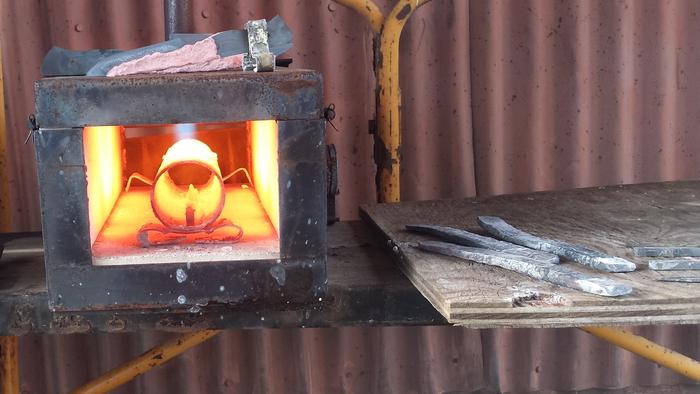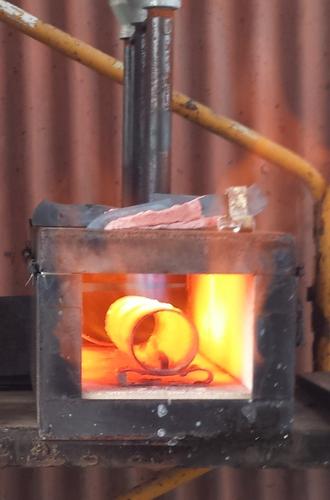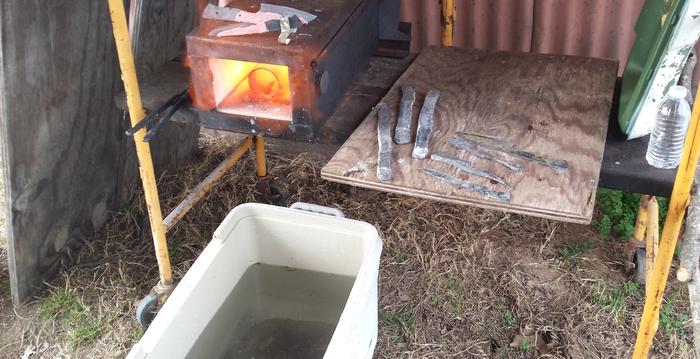Results 31 to 40 of 52
Thread: Coil spring steel crumbling
-
03-20-2014, 02:15 PM #31

As far as I understood it, water quenching is better for this purposes because getting a hamon requires that the temperature of one piece of the steel drops rapidly while another part colls down more slowly. With a water quench you are going to get a much steeper temperature gradient than with oil, and thus a much sharper hamon.
The downside is that the mechanical stresses are much bigger as well. Oil quenching is relatively gentle in comparison with water quenching. If you water quench steel that is thin and has any residual stress, it can warp badly or even tear itself apart. On a whim I once tried water quenching O1 razors. I decided that water quenching O1 is perfect if you like banana shaped razors
I was told that 10xx is much better suited to water quench.Til shade is gone, til water is gone, Into the shadow with teeth bared, screaming defiance with the last breath.
To spit in Sightblinder’s eye on the Last Day
-
03-20-2014, 04:51 PM #32"My words are of iron..."


- Join Date
- Oct 2006
- Posts
- 1,898
Thanked: 995
This is true and the lower the carbon content the better. Around 1060 will produce the best hamon (hardening line and associated structures). Most folks don't think it is enough to make a good knife/razor. Carbon content around 0.95% is riskier because it tends to crack more (the dreaded ping) than 0.60%, but everyone knows it's better knife steel. I would also recommend finding this plain Jane type of steel with the lowest manganese content possible to avoid through hardening problems. Manganese above 0.5% makes it difficult to get good hardening lines as the blade tends to want to harden all the way through rather than form a discrete boundary at a defined thickness. This can be overcome by using a clay coating to delay the quench time at the spine or by defining the blade with a thicker spine and steep taper to the edge. Lots of stuff to think about.
I have never had to use brine in a 10XX steel to achieve a hamon. Plain clean water...
Peanut oil plus O-1 at time and temperature equals ?Last edited by Mike Blue; 03-20-2014 at 04:53 PM.
-
The Following User Says Thank You to Mike Blue For This Useful Post:
spazola (03-20-2014)
-
03-21-2014, 01:39 AM #33Senior Member

- Join Date
- Oct 2008
- Location
- Tolland, CT
- Posts
- 263
Thanked: 85
Let’s see, 5 gallons of Mazzola corn oil sells for $99.80 (including shipping) on Amazon, and 5 gallons of GLOC Quench A costs $67.81 from USA Knife Maker Supply (shipping unknown). Assuming the shipping costs are similar, the two oils cost about the same. One is engineered for quenching steel, and the other is intended for cooking. While I will concede that the corn oil smells better, I stand by my statements, which were in answer to a question posed by another forum member. Everyone here is free to embrace or reject my opinions, without trying to make things personal.
-
03-21-2014, 06:17 AM #34

We have tested this, and with proper temperature control before the quench, you will get predictable hardness and toughness results that are the same as when you use expensive oils, or so close that is it negligible. This has been verified using Rockwell testing and break testing. And that is with using proper temperature control. Without proper temperature controls, there is more variance than what is caused by the difference between one oil and another.
Most of what is dicsussed here, has been tested and verified by more than one person. Not just regarding heat treatment, but also concerning various other types of techniques. That raises the bar from opinion to facts. So it doesn't have very much to do with accepting someone's opinion, but accepting facts that have been measured.Til shade is gone, til water is gone, Into the shadow with teeth bared, screaming defiance with the last breath.
To spit in Sightblinder’s eye on the Last Day
-
03-21-2014, 03:05 PM #35Senior Member

- Join Date
- Nov 2013
- Location
- Houston, TX
- Posts
- 147
Thanked: 45
Yeah, I think I'd go with Mike on this one. Knife makers usually do get pretty weird about their processes. I can't even get through some of the HT posts I've read on bladeforums because the rituals are so strange. I personally have only used quenching oil, but will definitely try canola. I have heard more than one amazing knife maker say that they use canola, peanut, or corn oil.
I think that oil is pretty much oil. Unless you're going to go to do salt bath HT, I don't think there's much of a difference. Anyone know if Kevin Cashen is on this forum? He'd be a great one (not that Mike isn't the authority on this ) to hear from.
Let me know if you need any help with shaving, honing, etc.
) to hear from.
Let me know if you need any help with shaving, honing, etc.
-
03-21-2014, 03:45 PM #36Senior Member

- Join Date
- Mar 2011
- Location
- Corcoran, Minnesota
- Posts
- 665
Thanked: 170
One knifemaker I visited said you had to quench with the blade facing north/south, or bad things would happen. I think what this interesting conversation proves is that there are many ways to skin the cat, and they all work for the folks that have used them successfully. I'm a magnet for thermometer and free McDonalds fry oil guy. And I'm working on a set of salt tanks. What is important is consistent, controllable results. The rest is personal preference. Namaste.
-
03-21-2014, 03:58 PM #37Senior Member

- Join Date
- Nov 2013
- Location
- Houston, TX
- Posts
- 147
Thanked: 45
Completely agree there. I prefer a pyrometer to a magnet, but that's not to say the magnet won't work! I'm interested in salt baths, but it seems like a ton of cost, work, and risk (exploding salts
 ). Cryo is also interesting to me. I've cryoed a couple of blades that I made out of AEB-L and they got really sharp and stayed that way...I guess, in the end, it's the weird rituals (some effective, some debatable) that keep us engaged and pressing forward as we have for hundreds of years.
). Cryo is also interesting to me. I've cryoed a couple of blades that I made out of AEB-L and they got really sharp and stayed that way...I guess, in the end, it's the weird rituals (some effective, some debatable) that keep us engaged and pressing forward as we have for hundreds of years.
Let me know if you need any help with shaving, honing, etc.
-
03-21-2014, 04:18 PM #38"My words are of iron..."


- Join Date
- Oct 2006
- Posts
- 1,898
Thanked: 995
I know Kevin Cashen personally and for many years. I understand why he says what he does and the way in which he says it, and I have no problem with his information or his purpose. He fights the hype that accumulates and I respect anyone who simply lays out the truth for all to see.
How he might choose to solve this problem in his shop will always be his choice, as is mine and yours Chris. What I propose is a spectrum of tools and equipment that allow each smith an effective approach to solving the problem of heat treatment without limiting that choice. When I teach heat treatment, the first question I ask of the learner is "what equipment do you have in your shop at home?" I can show a student how to heat treat with high and low temperature salt baths and precise thermal controls because that's what I have in my shop. How can they go home and duplicate my results in my shop with a bucket of oil and a coal forge? They need to learn on the equipment they have, that they can afford, that they can get to work and build a data set for themselves.
If you want to react to my comments as if they are personal, indeed they are from a student's perspective. They reflect my intent to give every learner an equal chance at success given the equipment they have. Once they arrive at a point where they want to up their game to the next level and invest in higher tech equipment, that should be their choice too. It is not for me to say that the knife, or razor, they made with simple shop equipment somehow does not meet the "good enough" standard of a working tool. Chasing perfection can be frustrating and cause good people to leave this craft. We should not tempt people with it.
-
03-21-2014, 04:23 PM #39"My words are of iron..."


- Join Date
- Oct 2006
- Posts
- 1,898
Thanked: 995
Exactly. Human beings are keen observers and noticed when something worked and something didn't. The rituals developed to help the next generation remember how to duplicate previous results or prevent knowledge from being lost. I can't recall how many experiments I've repeated because someone said "this works better..., or you can't do that." just because I was stubborn and had to find out for myself. I learned a lot.
-
03-22-2014, 05:44 AM #40aka shooter74743




- Join Date
- Sep 2009
- Location
- SE Oklahoma/NE Texas
- Posts
- 7,285
- Blog Entries
- 4
Thanked: 1936
Well, I went to Walmart and picked up a 40lb bag of pure salt for $7.00. Dumped half of it into a old ice chest and filled the chest up half way with water. it sat for half a day while I finished up the batch of 4 knives and 3 razors that are in 1095. Said a short prayer and proceeded to heat treat them. One of the big knives pinged (actually didn't hear it or feel it though). The three "bars" you see there are more of the crumbling steel that I keep around for heating up the quenchant.


 Southeastern Oklahoma/Northeastern Texas helper. Please don't hesitate to contact me.
Southeastern Oklahoma/Northeastern Texas helper. Please don't hesitate to contact me.
Thank you and God Bless, Scott


 45Likes
45Likes LinkBack URL
LinkBack URL About LinkBacks
About LinkBacks








 Reply With Quote
Reply With Quote